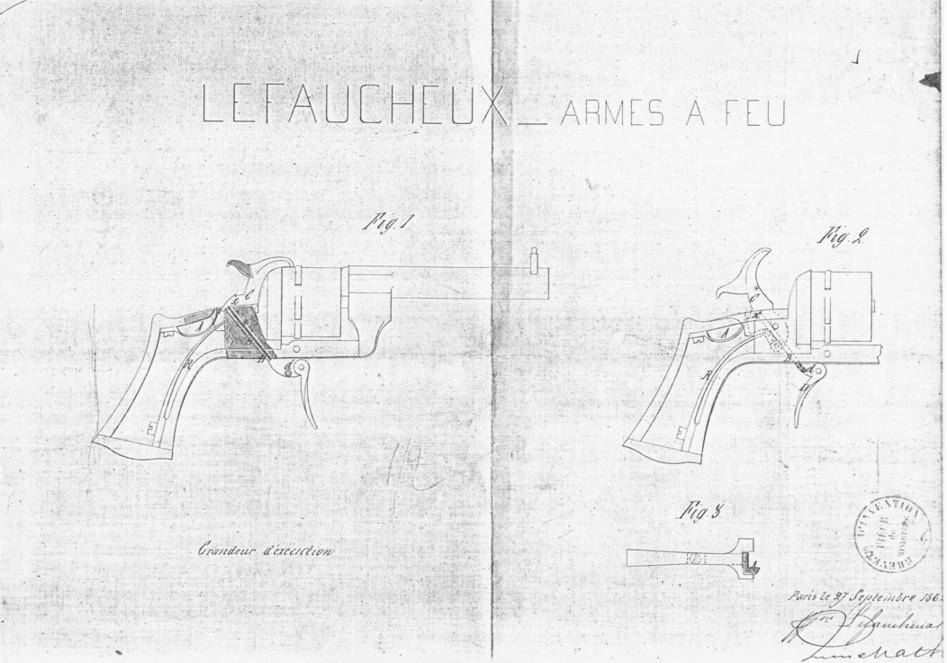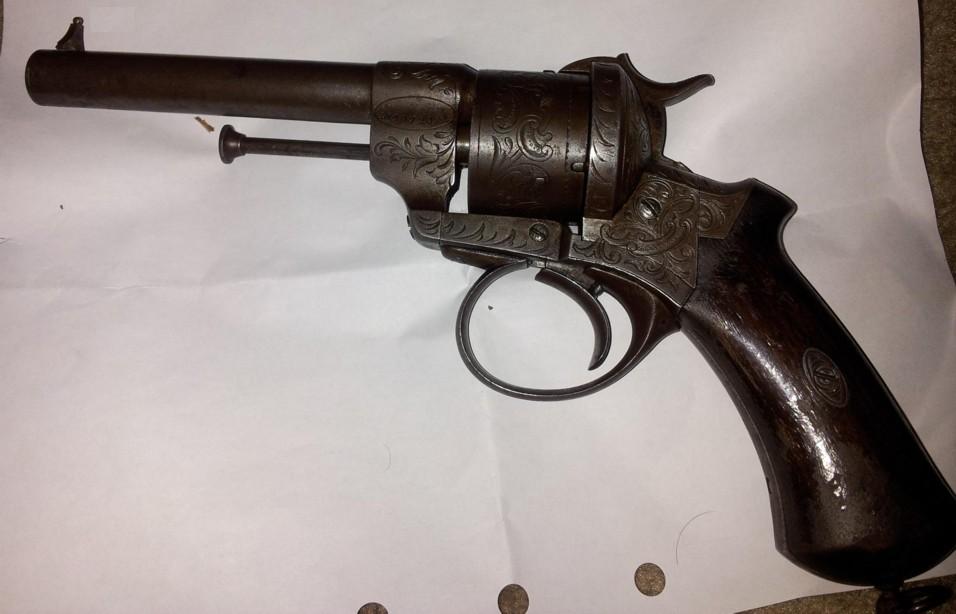
Lefaucheux Triple Action
Revolver
pinfire 12 mm with a mechanism in triple action, resulting from the patent of
1862.
The LF
10720 is the serial number of the weapon.
The
“Invon E. Lefaucheux patented s.g.d.g. in Paris” under the barrel, on the level
of the central axis proves that the weapon was manufactured by Eugene Lefaucheux
in the workshops of the 104 street Lafayette in Paris.
The “E.
Lefaucheux Bté à Paris” on the barrel indicates a marketing by its care.
The
significance of “G” and the “6” are to me for the moment unknown factor.
“Late”
manufacture (after 1865) due to the fact of its number LF and the grips (heel)
very round (on the first series the head of the screws are apparent).
Weapon in
version “luxates” since finely engraved.
Guillaume

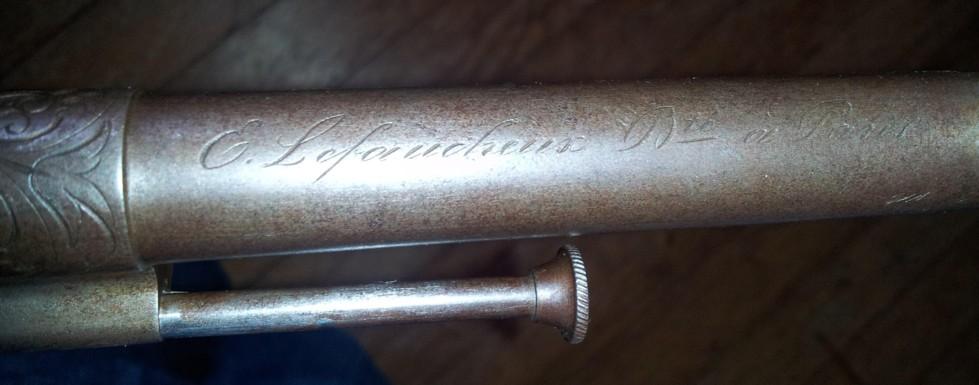
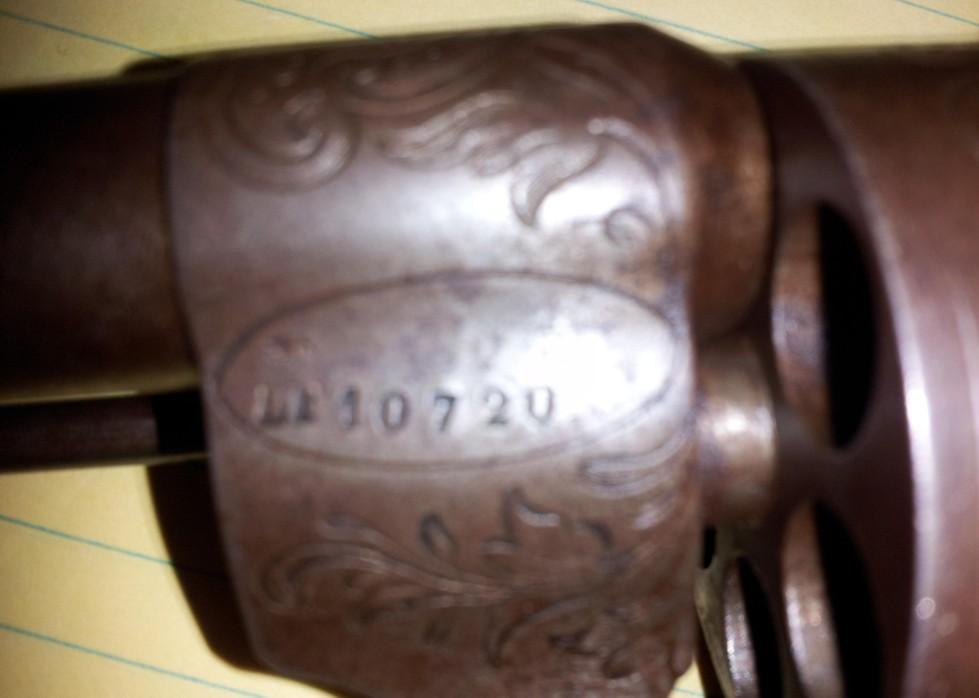
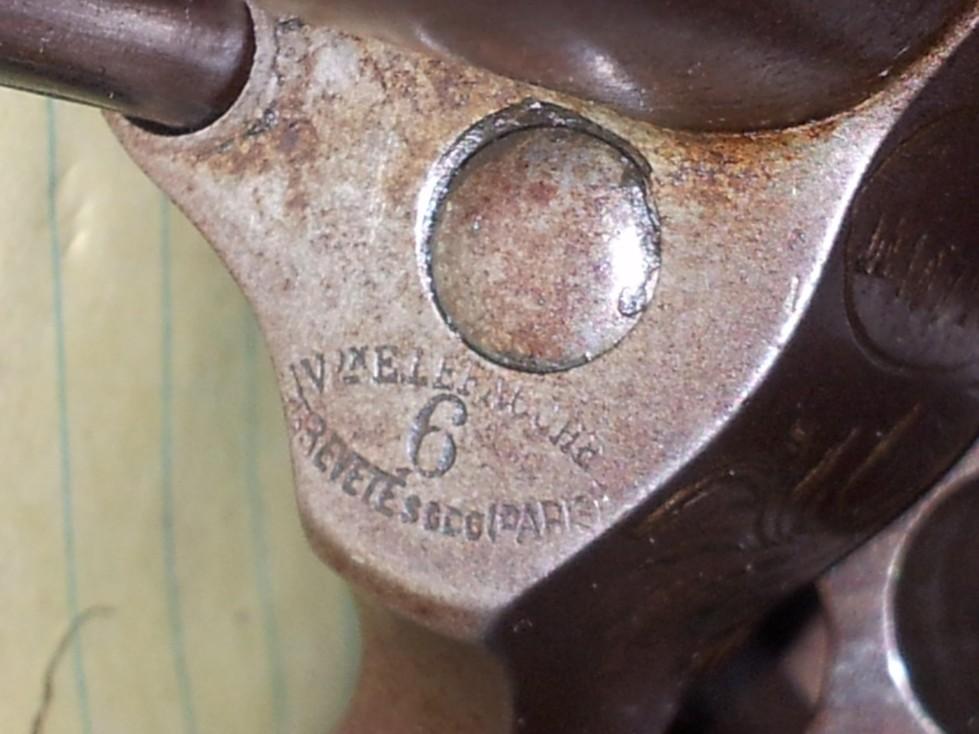
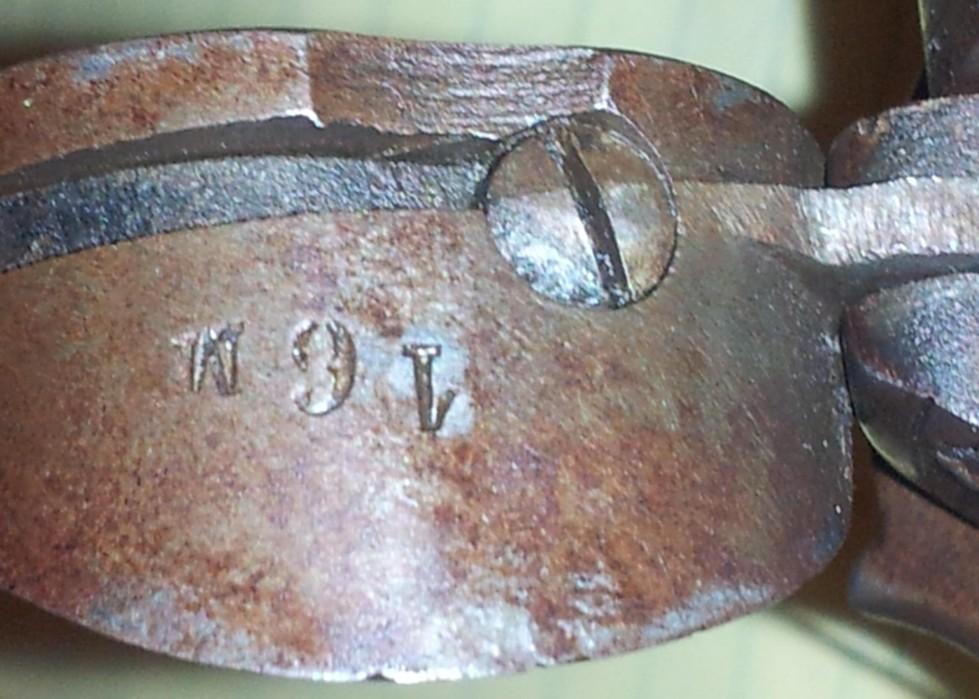
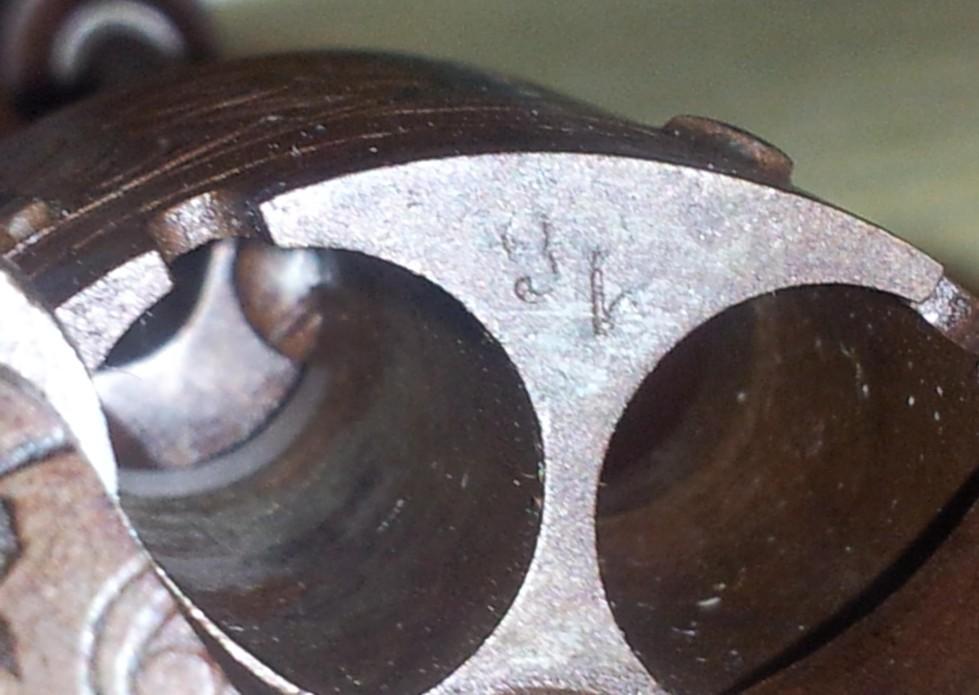
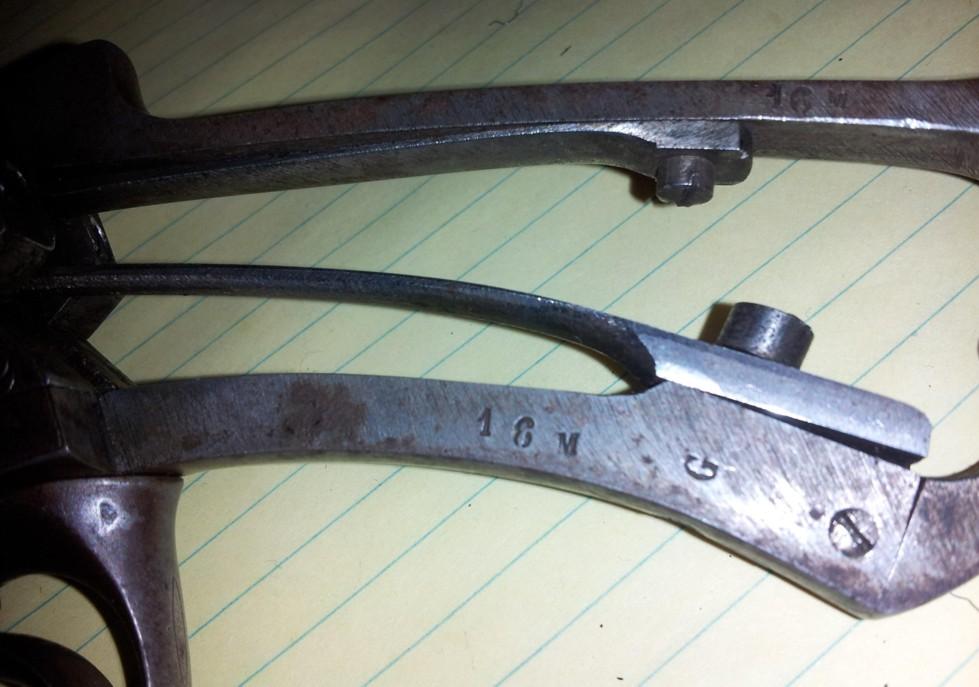
Lefaucheux Triple Action
The Lefaucheux LF 68.
You all know the 12 mm Triple Action revolver with 6 shots.
I present to you here one of the very rare revolvers, 12 mm in TA, but with 10
shots, the "LF 68".
The production of these 12 mm TA with 10 shots was very low, probably less than
a hundred. (Subject to verification).
All the numbers noted on the weapons in 12 mm, TA and 10 shots, are currently
between the "LF 68" and the "LF 582".
The general appearance of the weapon (apart from its fluted cylinder and its
"massive look"), as well as the internal mechanism do not change compared to the
classic 6 shots.
Principle of the mechanism:
Extract from the patent:
"The purpose of this invention is to give three movements to the hammer of the
weapon, that is to say that one can at will:
1. cock the hammer by the crest, as in ordinary weapons.
2. cock by the trigger with continuous fire and without it being fixed at the
end of its travel.
3. one can also cock the hammer by pressing the trigger and, at the will of the
shooter, leave it fixed, as if it had been cocked by its crest.
These three methods of cocking are obtained by only two parts and a reserve or
iron projection left on the trigger, which is infinitely simpler than all the
arrangements made until now to obtain the same result. "
Characteristics of the weapon:
Weight: 1130 grams (empty)
Total length: 290 mm
Length of the barrel (including thunder): 155 mm round.
Length of the thunderbolt: 32 mm, rounded shape.
Grooves in the barrel: 4
Length of the barrel: 29 mm
Diameter of the barrel: 58 mm
Caliber and number of shots: 12 mm pinfire, 10 shots.
Mechanism: triple action.
Wooden plates held by a central rosette.
Heel of the rounded butt with its lanyard ring.
Hallmarks and markings:
Like all the weapons produced by Eugène Lefaucheux, it is flanked by his famous
LF surmounted by the pistol followed by his number 68, therefore "LF 68", on the
left side of the thunderbolt, like most Triple Action (except for the first
series).
Eugène Lefaucheux is the manufacturer of this weapon but it was marketed by:
"LEPAGE FRERES A PARIS, 12 RUE D'ENGHIEN" as indicated on the top of the barrel.
Under the barrel, in front of the central axis, in an oval:
“INVon E. LEFAUCHEUX BREVETE S.G.D.G. (PARIS)” and a 2.
All the parts of the weapon have the manufacturing number “87”
® and © Lefaucheux April 2013

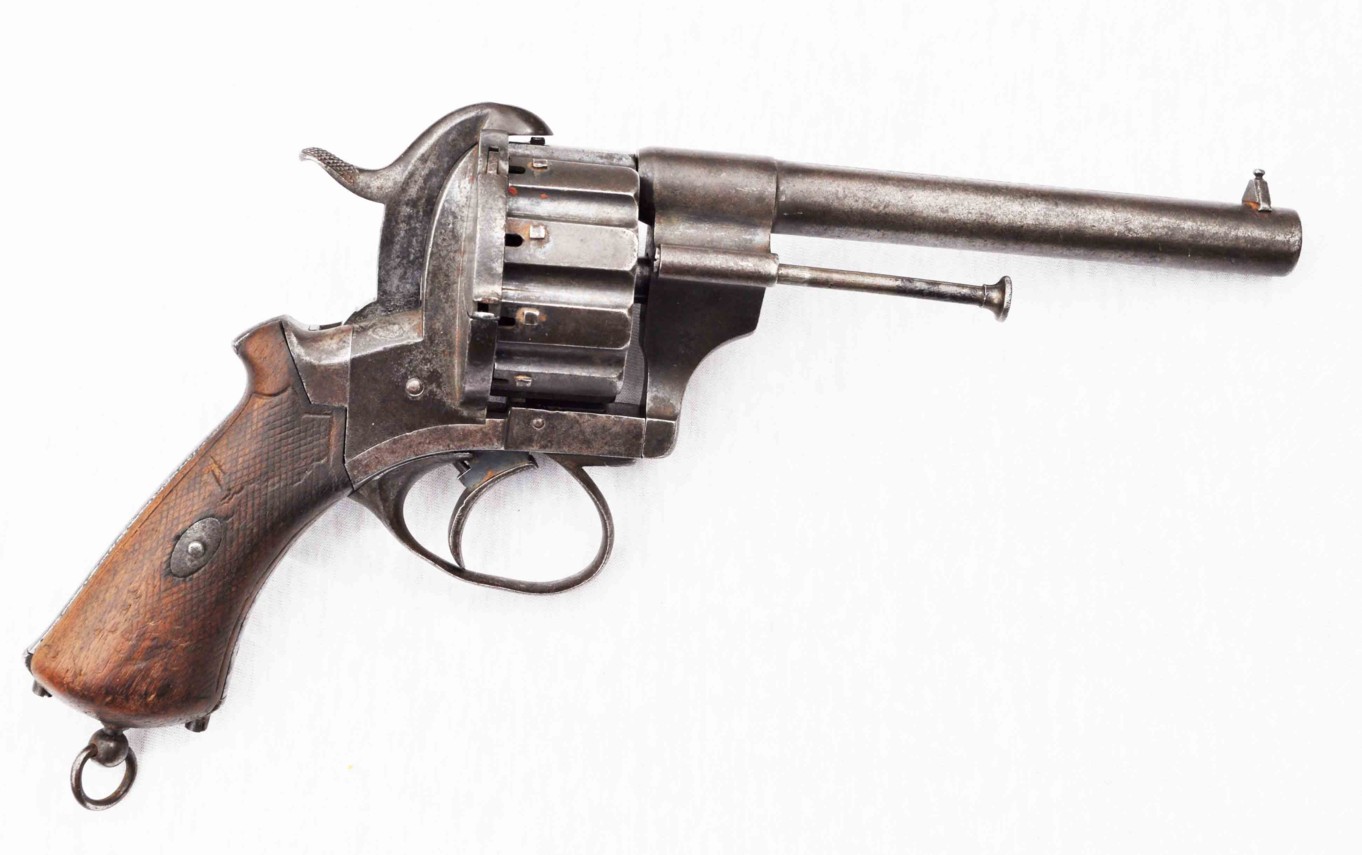
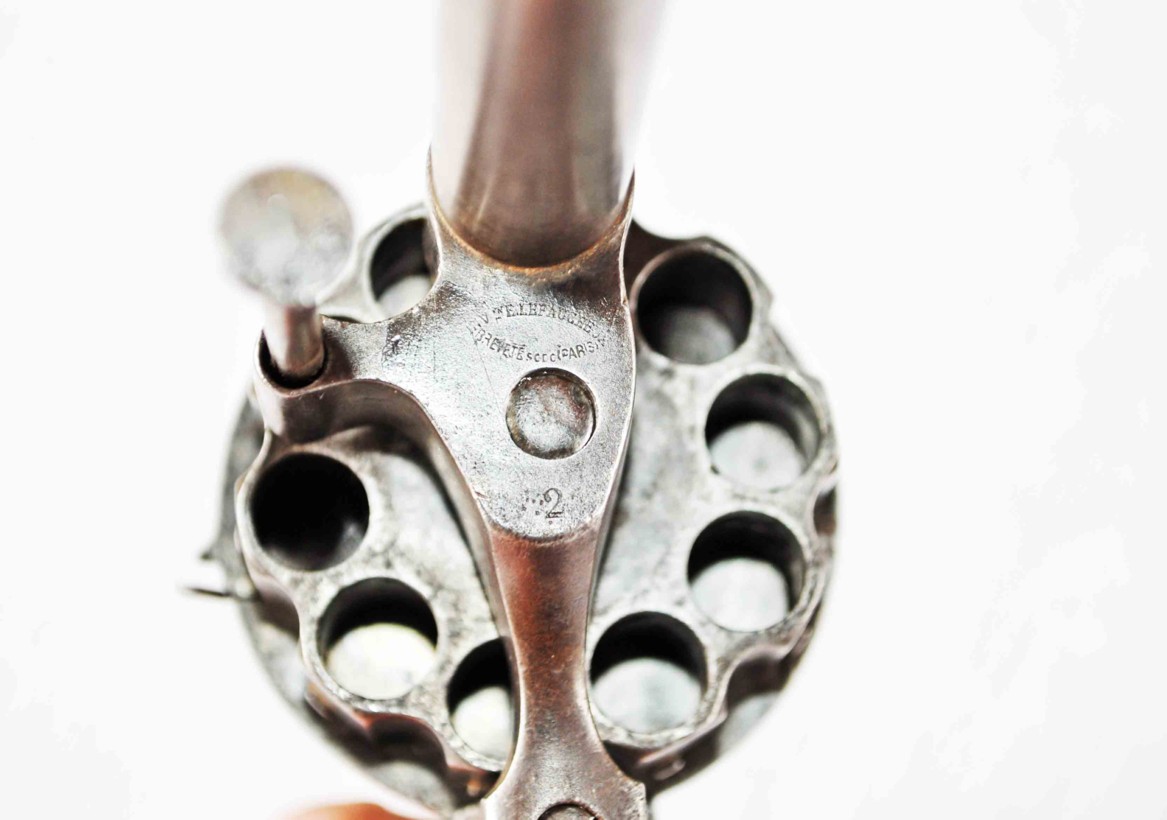
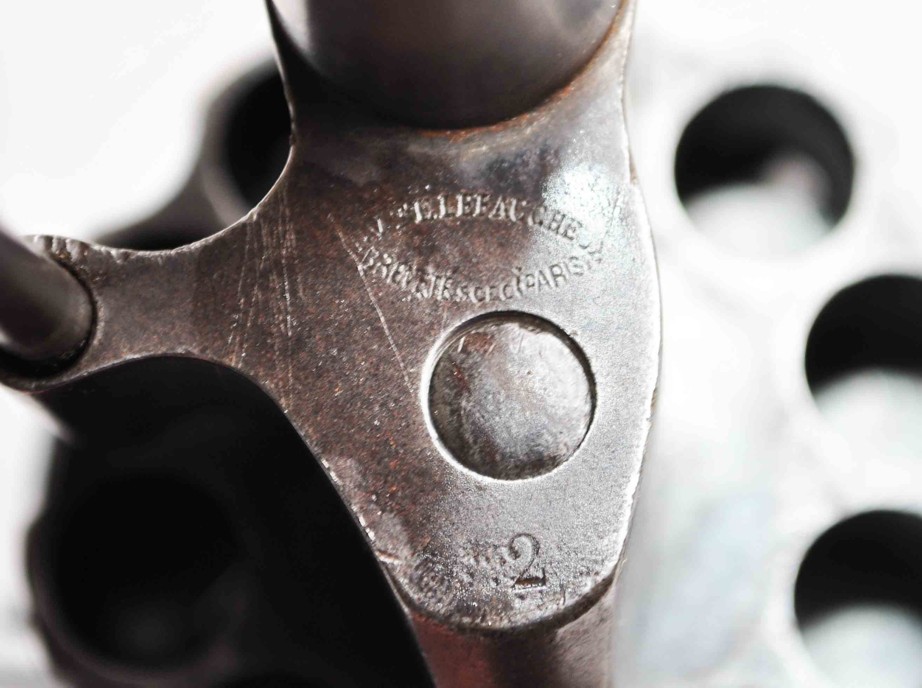
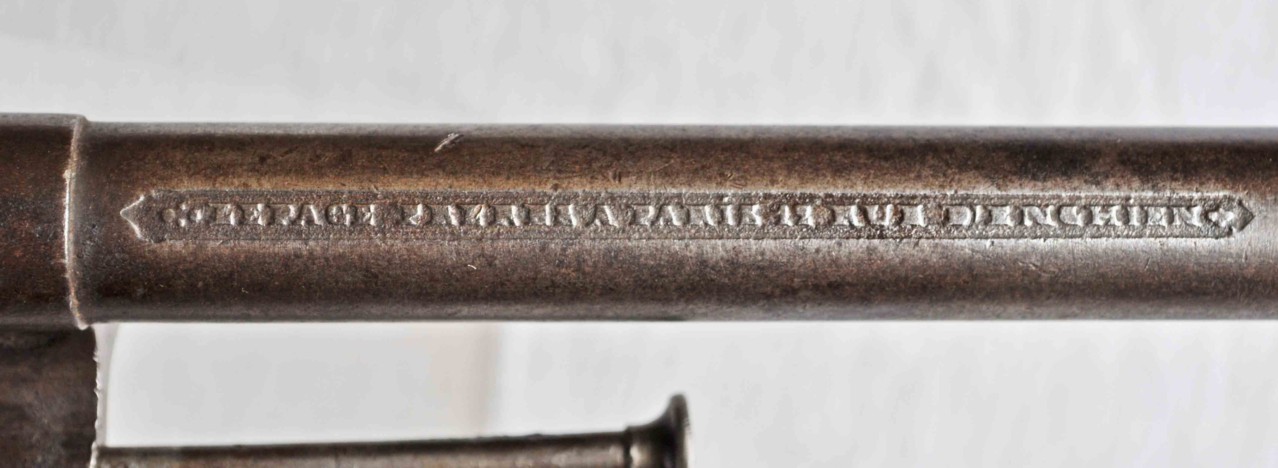
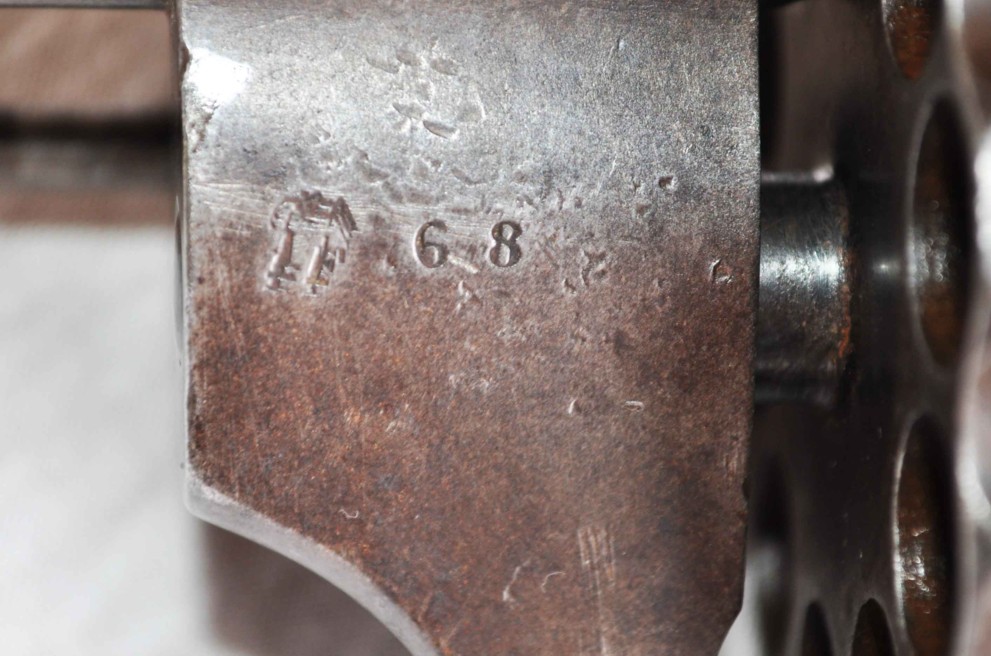
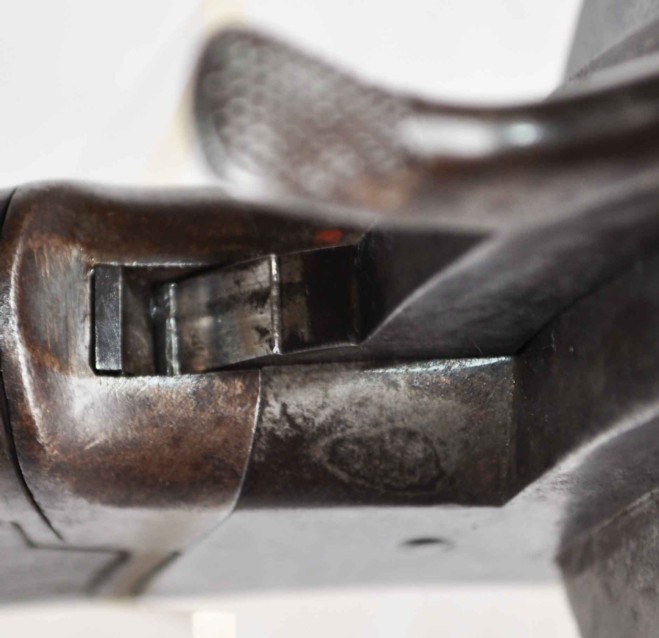
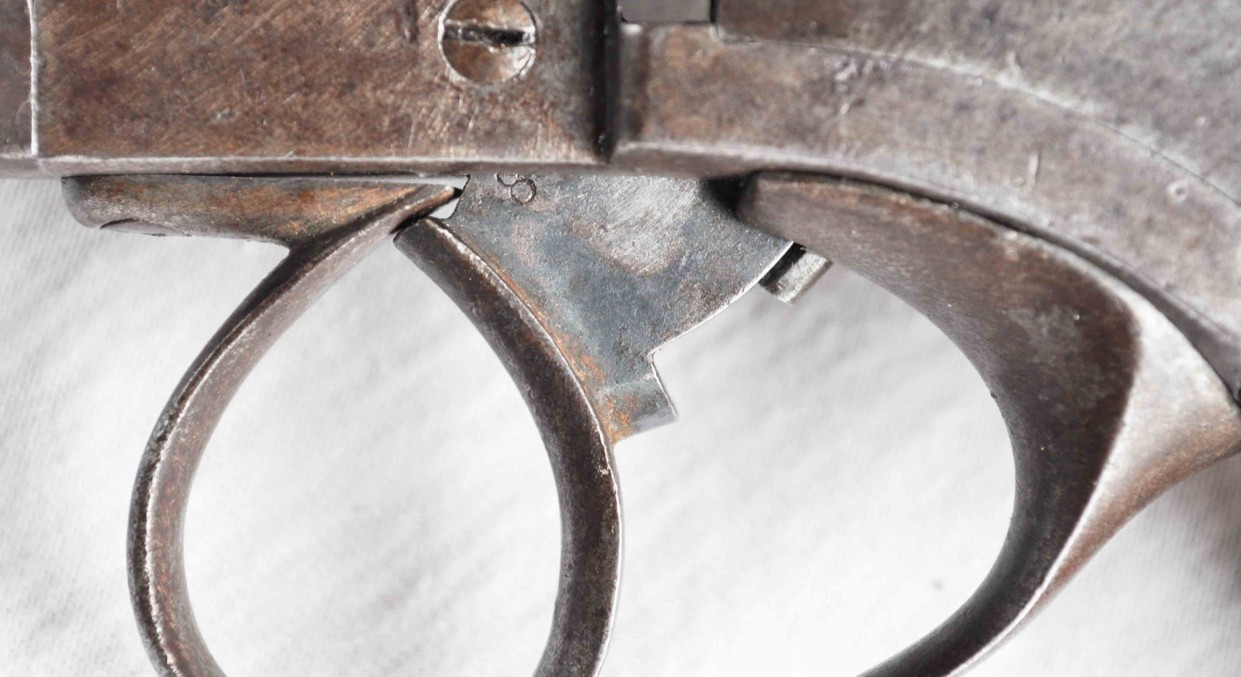

Lefaucheux Triple Action
The LF 5997, a 9 mm Triple Action, manufactured in Paris at 104 rue Lafayette around June/July 1864. (In 1865 the street number became 194).
Guillaume
Lefaucheux Triple Action
Lefaucheux revolver luxuriously engraved and presented out of box.
It is a model called “to triple action” according to patent 55784 of September 27, 1862, calibres 12 mm pinfire.
Markings:
- on the barrel: E. Lefaucheux Bté in Paris
- on the console on the left-hand side: LF 8594 with the broken pistol
- on the other in-house parts: 84 R
Its length is among 290 mm and that of the barrel of 155mm.
The accessories present in the box are:
- a cleaning-rod
- a tool to be gauged
- a tool allowing the installation of the fulminate capsules in the casings.
This revolver is in a new state and probably drew very little.
Gilles
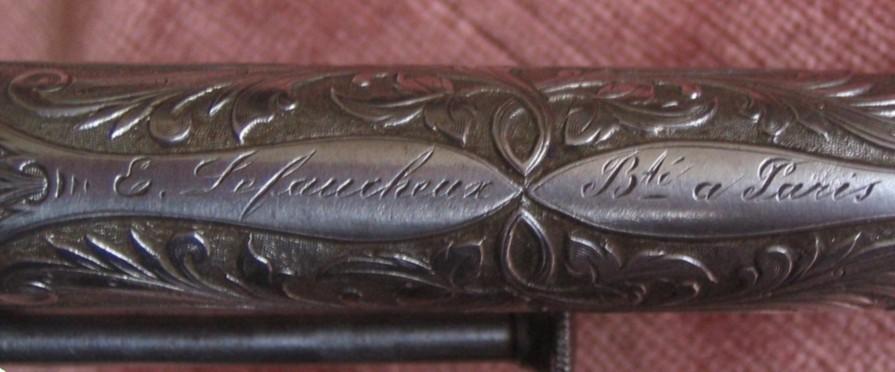
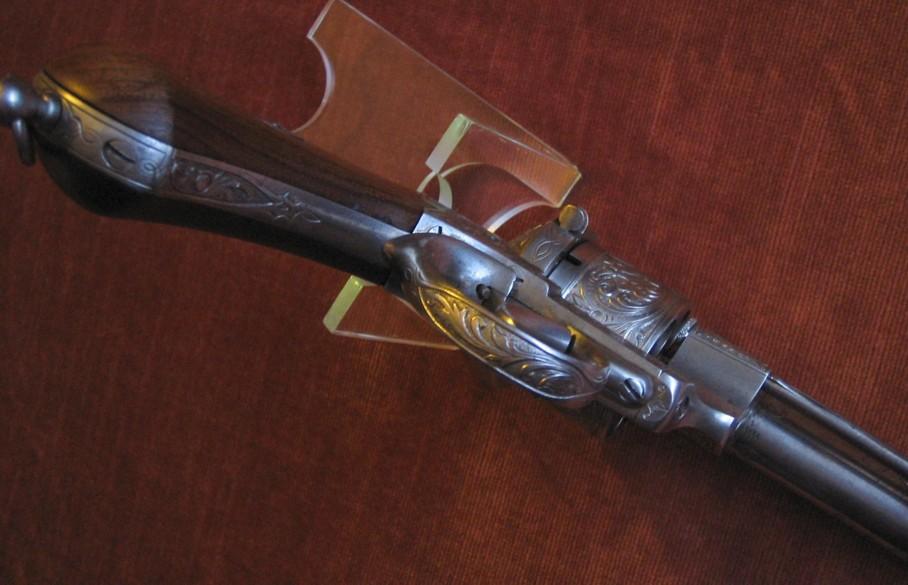
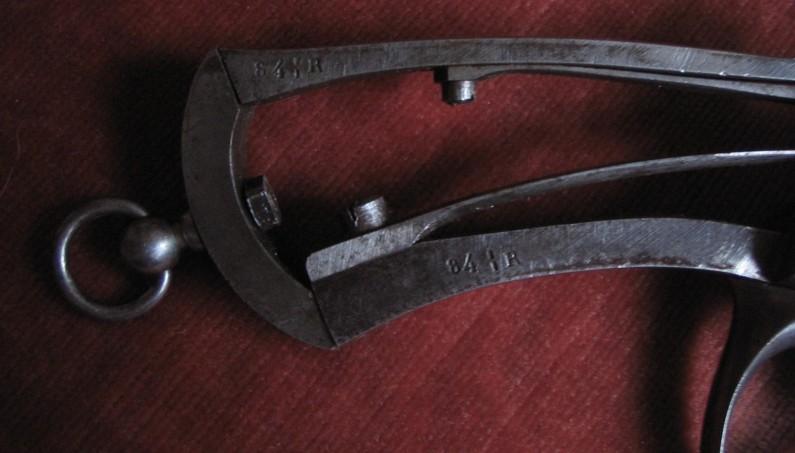
Lefaucheux Triple Action
Description of the Lefaucheux 9 mm Pinfire, in Triple Action, LF 4223.
The Patent of the Triple Action is deposed by Lefaucheux in Paris on September 27, 1862 under the number 55784 and on October 3, 1862 in Belgium under the number 13277.
Eugene had high hopes on the mechanism Triple Action.
First, the design of the patent proves it was 7 mm for revolvers, then the mechanism evolved to be adapted to 12 mm pinfire (but also Central fire) in the hope of selling to the army, unfortunately ... without much success.
Reason: mechanism complicated and fragile to be placed in the hands of the troops.
We find the mechanism Triple Action on 7 mm revolvers "barrel multi-shots at 18, 20 shots, but rarely on the 9 mm to 6 shots like the one described here.
Principle of Triple Action:
The TA is the combination of SA and the DA and the ability to switch from one to another, and hesitate to go back.
Reminder:
SINGLE ACTION:
It pulls the hammer back with the thumb.
Once cocked, pressing the trigger to fire.
To fire again, you renew the operation of cocking the hammer.
DOUBLE ACTION:
It is also called "continuous fire", that is to say we fired by pulling only the trigger.
TRIPLE ACTION:
It is the combination of both with the option of transferring from one to another in the same movement and return.
Either you arm all the way back by pulling on the hammer and pull the trigger .... SA
Either you press the trigger continuously .... DA.
But on the Triple Action, there are notches in between.
Lightly squeeze the trigger, the hammer gets up and hangs on a notch.
This notch allows 3 things.
1: the free rotation of the barrel for the "re" or unloading.
2: to hesitate, that is to say to aim and keep pulling the trigger. There are two possibilities: to fire by pressing to the bottom the trigger or move the hammer to the arms (as in SA, but pressing by the trigger), again a little pressure and the gun goes off .....
3: or arming the hammer as in SA, aim and fire by pressing the trigger.
This same movement is also possible with the hammer:
1: Pull lightly on the hammer, it hangs at the first stop.
2: there are three possibilities: either we continue in SA, it is fired by pressing to the bottom the trigger, or we take the hammer to the arms (as in SA, with expansion), again a little pressure and the gun goes off .....
So a first movement in SA and a way to finish the move in DA or the reverse (starting in DA and finish in SA).
The mechanism of the TA is also called "the hesitation"
The hammer is cocked, but you no longer wants to fire.
Arming the trigger with the pin, it is becomes near the small metal rod.
Holding the hammer while urging the trigger, the pin will push the rod.
The rod will release the notch, allowing the hammer to return quietly to the rest position.
Not always easy to understand and delicate mechanism is probably the reason why the military never wanted such weapons in the hands of the troops.
LF 4223, Model 9 mm Triple Action, well-rounded, like those in 12 mm, has lost its angular shapes of the 7 mm.
It is a like the model of 12 mm, with two small differences, however, that classify the weapon in the category of "weapons of pocket", namely:
Lack of trigger guard, so a folding trigger as all the 7 mm.
The absence of ring strap at the heel of the butt.
Inscriptions and Proofmarks:
All parts contains the number 54 O.
The curiosity of this revolver is to found on the barrel:
Normally marking LF, with the gun broke above is found according to the series, either left or right of the barrel.
Here we find on the barrel a LF without a number on the right and LF 4223 on the left.
Again with a curiosity, the left LF has been hit by "double" ... .. probably due to the awkwardness of the worker.
On top of the barrel:
"E. Lefaucheux Bte. in Paris "
Below the barrel, the location of the centerline, in an oval with a 0 in the middle:
"Invon. E. Lefaucheux s.g.d.g. (Paris)"
In the trigger, in a oval, partially offset by friction:
"Invon. E. Lefaucheux s.g.d.g. (Paris)"
Under the grips of the butt, several marks: a J, a +, a P and AJ in an oval.
These are probably the proofmarks of those how worked on the weapon.
Specifications:
Weapon intended purely civil, carved crepes and leaves
Weight of weapon: 625 grams
Total length of the weapon: 210 mm
Barrel length: 100 mm
Loading gate: Right side in the breech, opening up above.
Rod ejection: Removable, with longitudinal spring.
Barrel: 6 shots, 9 mm pinfire
Length: 26 mm
Diameter: 36 mm
Breech: 44 mm
Mechanism: Triple Action.
Guillaume
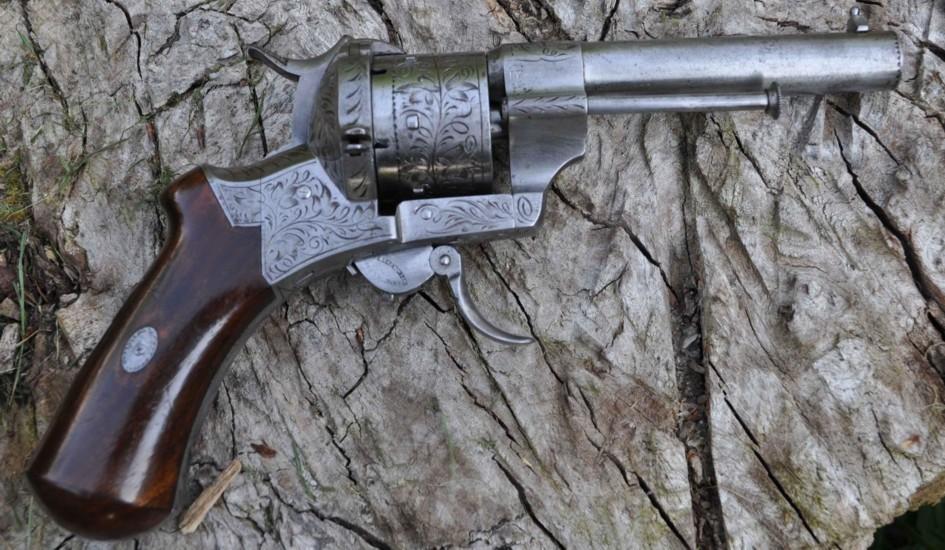
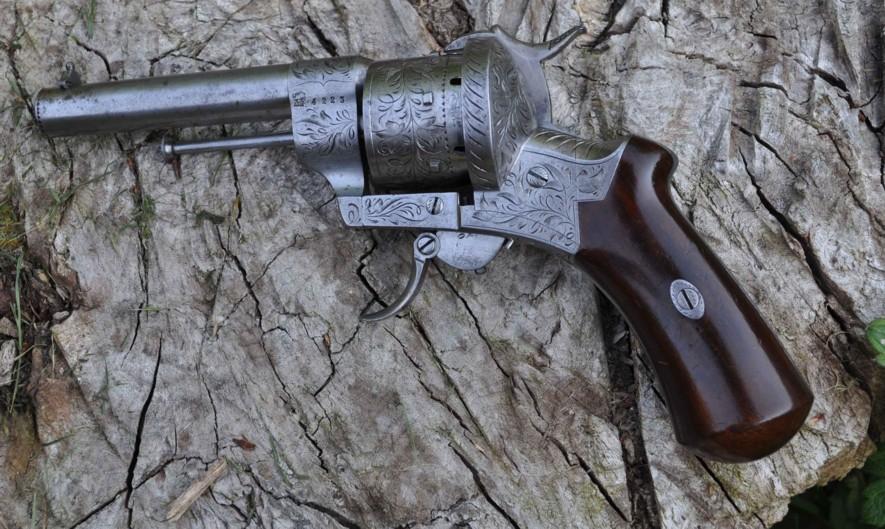

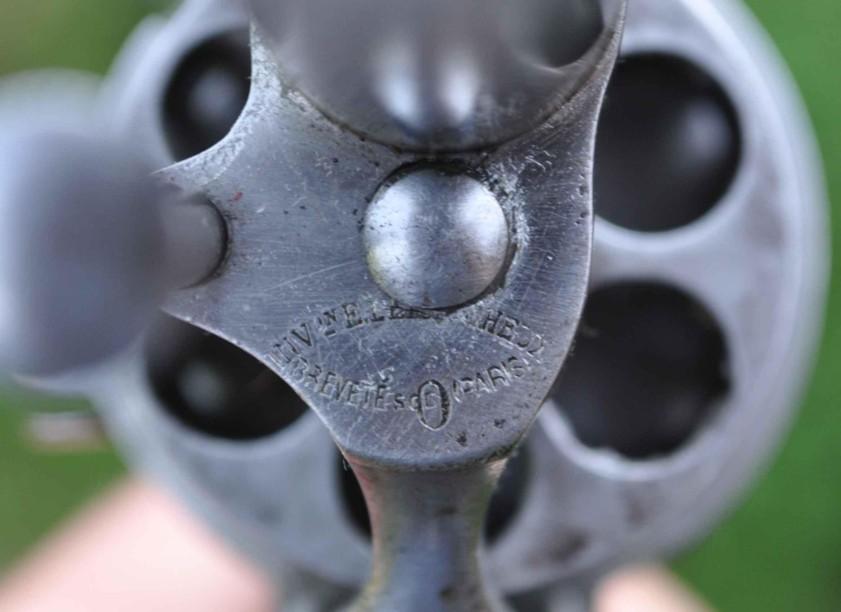
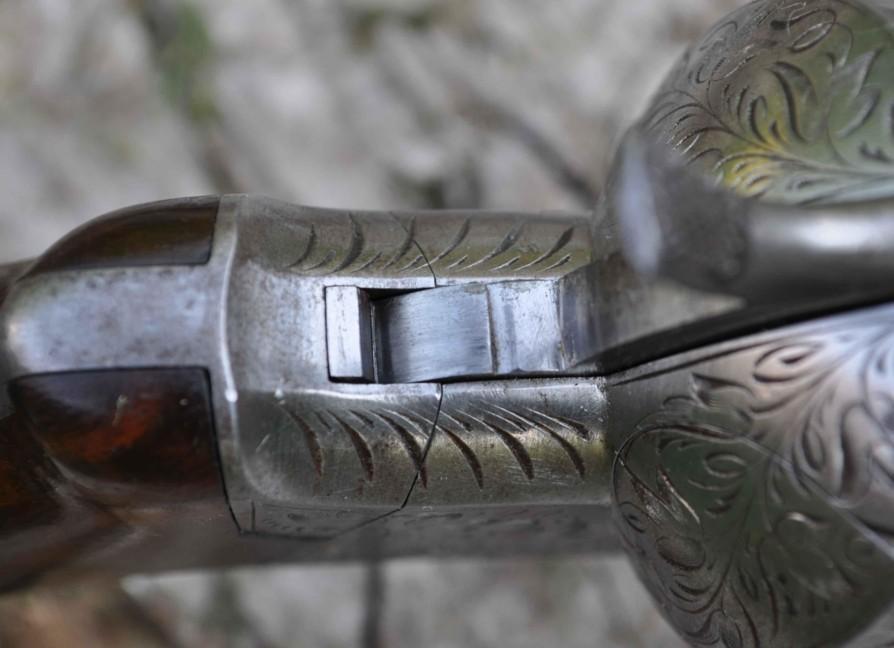
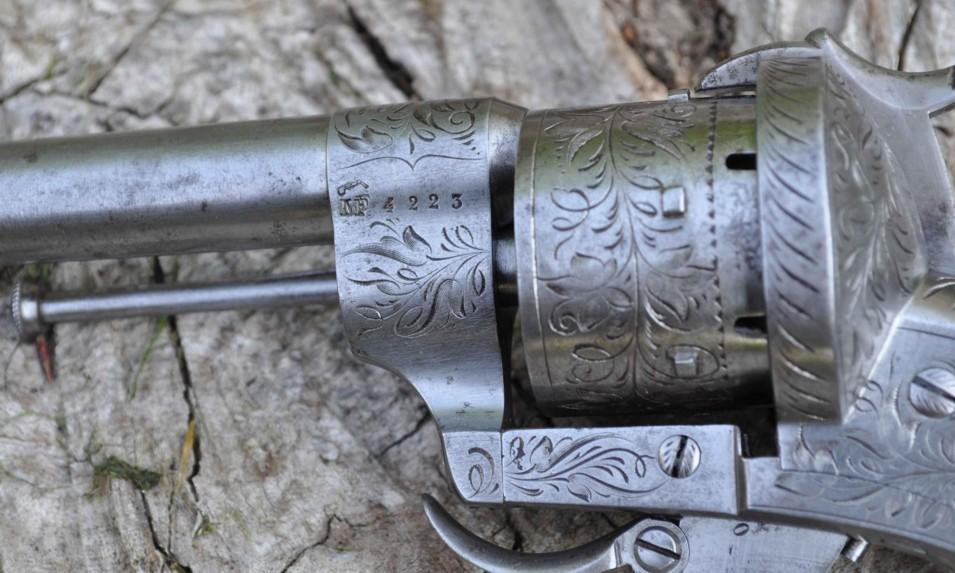
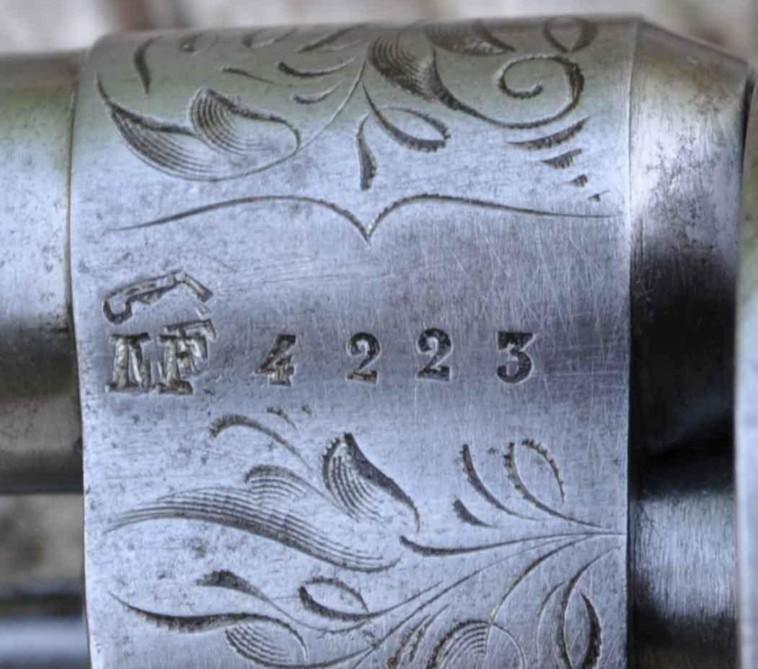
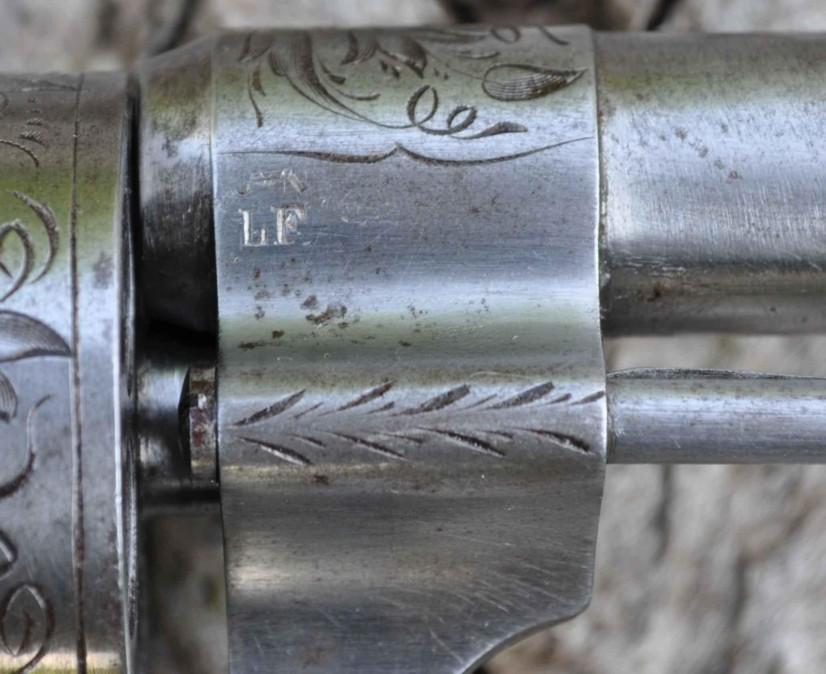
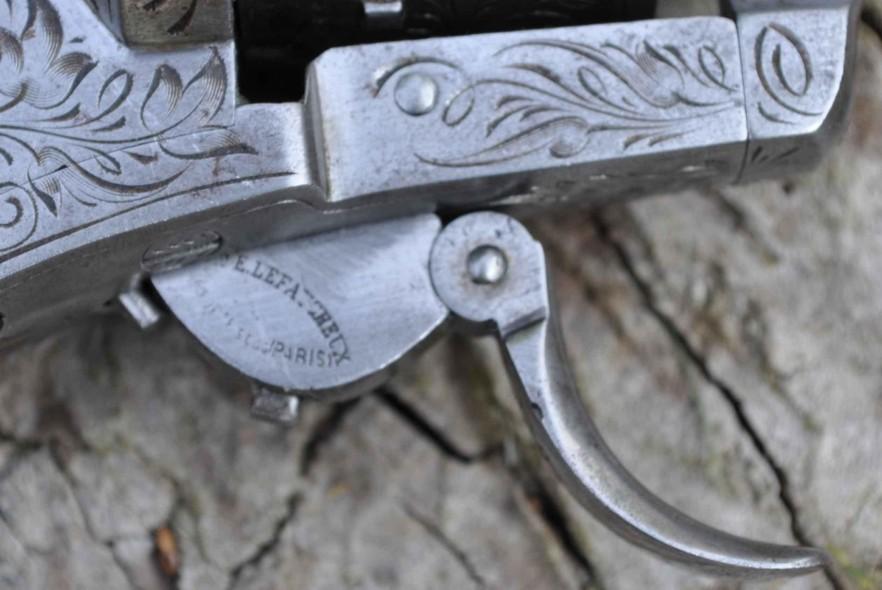
Lefaucheux 12 mm Triple Action
Lefaucheux 12 mm in Triple Action according to patent 55784 from September 27, 1862 with Civil and Military vocation.
Extract of the patent: “The purpose of This invention is to give three movements to the hammer of the weapon, i.e. which one can at will:
-To arm the hammer by the peak, as in the ordinary weapons.
-To arm by the trigger with continuous shooting and without it being fixed in end of its race.
-It can still arm the hammer while pressing on the trigger and, at the will of the gunner, to leave it fixes, as if it had been armed by its peak.
These three modes to arm are only obtained by two parts and one iron reserve or projection left on the trigger, which is infinitely simpler than all the provisions carried out to obtain the same result up to now.
Of rather simple mechanism, it will be built until 1868. It is the last type of open framework and pin revolver designed by Eugene.
Its carcass derives from model 54/58, modernized: more collected silhouette, disappearance of the sharp angles, embedded screws and bolts, mounting of stick in two parts only (the support of handle forms the back quarter of the lock body and the cap, before being embedded in the tail of under guard which forms the front branch of it).
The mechanism is entirely new, simple, easy to dismount and understand; it will be also assembled on the carcasses of 54/58 exits after 1862, then out of the 20 blows in 1864.
Entrusting in his weapon, Eugene presents it at the army in 1866, to compete with the PERRIN.
October 30, 1867 the central commission of imperial gendarmerie gives its conclusions: preference is given to the PERRIN.
Nevertheless Lefaucheux TA will be useful in the Norwegian and Swiss army.
Markings and punches
·Barrel: on the top: “Windisch Arqer in Nimes”
He is a retailer of weapons during the years 1830 - 1870
On the left thunder: LF 9633
On the lower part: 1
·On the breech in addition to the 97 Y, it there with the letter B
·The whole of the parts carries the same number: 97 Y
Current weight: 906 grams
Overall length: 260 mm
Length of the barrel: 137 mm with the thunder of 25 mm
Cylinder: 12 mm with pin, 6 blows
·Length: 30 mm
·Diameter: 42 mm
Barrel and round thunder, interior with 4 right grooves.
Plates of the stick out of dark wooden with ring of cap.
Guillaume
A French firm manufactures the necessary to reload this type of ammunition.
Look at here: H & C Collection
Description of Lefaucheux 7 mm in Triple Action
The model of Lefaucheux 7 mm pinfire, 6 shots with Triple Action is relatively rare nowadays.
Its patent, number 55784 was deposited on September 27, 1862 in Paris.
From appearance this 7 mm TA does not differ of anything traditional the 7 mm in DA; even carcass, even stick, with share the small pin on the right side of the trigger, the notch on the carcass with the back of the hammer, the peak on the hammer and the “barbs” on the barrel.
Another difference is the site of marking LF: on traditional SA and DA this punch this finds either on the right thunder, or on the console, above the trigger.
On MT this marking on finds in general below the left thunder.
Presentation of the weapon steel polished with squared grips.
On this weapon very few punches and markings:
On the top of the barrel “Vindisch in Nimes”.
(Arquebusier and retailer in Nimes in the years 1865.)
Below left thunder LF 14666 with the famous logo of the broken pistol.
Under the plate W.
The weapon is curious in these dimensions
- the standard overall length is in theory 210 mm to see 205 mm, that presented here makes 186 mm
- the length of the cylindrical or octagonal barrel is standard 84 mm, 88 mm or 91 mm, here it measure: 79 mm
- dimension standard cylinder, namely 26 mm out of 31 mm, 6 shots calibre 7 mm
Guillaume
